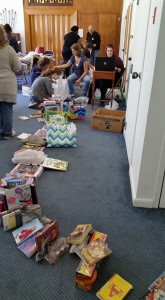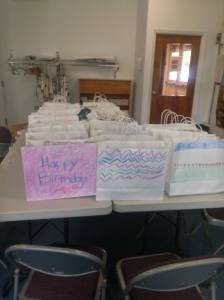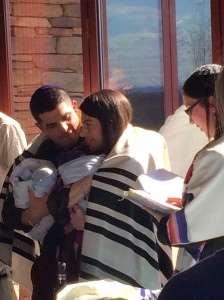
Generational Shabbat Sermon by Melissa Erlebacher
Good evening,
Let me tell you some of the events in history that occurred in 1913:
NYC’s Grand Central Terminal opened
After the 16th amendment was signed into law, the US federal income tax took effect
The 1st prize was inserted into a Cracker Jack box
Brooklyn Dodger’s Ebbets Field opened
The British House of Commons rejected women’s right to vote
The 1st US milch goat show was held in Rochester, NY
Henry Ford instituted the moving assembly line
The Hebrew language was officially used to teach in Palestinian schools
The 1st crossword puzzle (with 32 clues) was printed in NY World
And on January 21, 1913, 156 women from 52 congregations around the country met in Cincinnati, Ohio, under the leadership of Carrie Obendorfer Simon, to create the National Federation of Temple Sisterhoods, which was officially renamed in 1993 as the Women of Reform Judaism. While local women’s groups had been formed in many individual synagogues in the 1890s, and first decade of the 20th Century, the National Federation of Temple Sisterhoods (NFTS) was the first national organization to bring these groups together. Differentiating itself from the National Council of Jewish Women, Hadassah, and other social service women’s groups, NFTS focused from the beginning on women’s contributions to their own synagogues. Early projects included sponsoring children’s holiday parties, beautifying synagogues for holidays, and supporting the religious schools. NFTS also raised money for rabbinical school scholarships and played a leading role in creating the National Federation of Temple Youth.
NFTS encouraged sisterhood women to create in their temples a spirit of welcoming community, and I quote “reminded members to bridge the distance between pulpit and congregation by sitting in the first row of the sanctuary, and suggested that they sponsor an hour of refreshments and sociability after Friday evening services.”
From its onset, Sisterhood advocated for changing the role of women in Reform Judaism. Leaders pushed for women to be able to sit on synagogue boards and, in the 1920s, instituted Sisterhood Sabbaths, during which, women both led services and delivered sermons. In 1963, NFTS called upon Reform Judaism to take up the question of women’s ordination as rabbis (the first Reform woman rabbi was ordained in 1972). In recent decades, WRJ has been active in addressing such issues as civil rights, child labor legislation, capital punishment, abortion rights, and currently pay equity, LGBTQ rights, and sustainability and climate change. In December 2007, WRJ published The Torah: A Women’s Commentary. After attending the launch party at the WRJ Assembly, Roni and I talked about the pride we felt at being present to witness such a significant accomplishment for Jewish women.
Flash forward to 2016, reform women have participated fully in synagogue life, from the Board to the bimah, for many years. The URJ and WRJ work together on many of the same issues, working hand in hand for social justice. Vassar Temple has our first woman rabbi. So perhaps this begs the question…do we still need a Sisterhood?
Sisterhood: the thought conjures up images of bespectacled, gray-haired ladies in the Temple kitchen baking & brewing coffee for an Oneg Shabbat; cooking for a temple dinner, or stocking the shelves of the Gift Shop for the annual Chanukah sale. In reality, the women who are doing these things come in all different shapes and sizes, ages, and backgrounds. In contrast to the 1920s, the women of Vassar Temple continue to cook dinners and sponsor Onegs (although tonight, as we lead the service, that role falls to our Men’s Club), not because women are relegated to the kitchen – we continue to nourish our fellow temple members because we are good at it!
I certainly don’t believe in separate but equal, but I do believe in equal, but different. Sisterhood is a place where women can deal with the pressures of modern life from the isolation of the stay at home mom, to the two career working family, to the growing number of women who are primary breadwinners, to the need for activity and purpose after retirement, to the desire to spend time with other women who share one’s values. One of the challenges, according to Rabbi Amy Perlin, is “How do we live true to our egalitarian values, while recognizing that men and women do need and seek separate time in gender specific groups?”
Rabbi Berkowitz recently shared with me the following:
A man came home from work and found his three children outside, still in their pajamas, playing in the mud, with empty food boxes and wrappers strewn all around the front yard.
Proceeding into the house, he found an even bigger mess. In the kitchen, dishes filled the sink, breakfast food was spilled on the counter, the fridge door was open wide, dog food was spilled on the floor, a broken glass lay under the table, and a small pile of sand was spread by the back door.
He quickly headed up the stairs, stepping over toys and more piles of clothes, looking for his wife. He was worried she might be ill, or that something serious had happened.
As he rushed to the bedroom, he found his wife still curled up in the bed in her pajamas, reading a novel.
She looked up at him, smiled, and asked how his day went. He looked at her bewildered and asked:
“What happened here today?’”
She again smiled and answered, “You know every day when you come home from work and you ask me what in the world I do all day?”
“Yes,” was his incredulous reply.
She answered, ‘”Well, today I didn’t do it.”
I share this story for two reasons: first, in tribute to all mothers during this Mother’s Day weekend (I wish all of you a very happy Mother’s Day) and second, to think about Vassar Temple without the Sisterhood. Can you imagine Vassar Temple without family dinners, without a Judaica shop? What would Friday nights be like if we all came to services, prayed, and then left because there was no longer an Oneg Shabbat. What about all of the fundraising Sisterhood has done to renovate the kitchen or to pay for needed repairs to our beloved building? Tiny Temple introduces our youngest members to Jewish rituals, and the holiday gifts we send to college students help them to stay connected to their temple home. Sisterhood enriches the life of Vassar Temple, as well as the lives of the women who work on its behalf. Personally, I know that my life has been made richer because of all of the women I have met, short or tall, young or old, for we all share a love of Reform Judaism, Jewish values, and Vassar Temple. Perhaps the question is not “Why Sisterhood” but rather, “What if there wasn’t a Sisterhood…” I hope we never need to ask that question.
Before I end, tonight, we not only celebrate the Sisterhood and Women of Reform Judaism, we also celebrate Generations Shabbat, recognizing those who have been members of Vassar Temple for 40 years or more. If you have been a member of Vassar Temple for 40+ years, please stand up…. Thank you for your loyal membership and for the immeasurable contributions you have made to our synagogue.
Shabbat Shalom.
Resources:
Nadell, Pamela. National Federation of Temple Sisterhoods. Retrieved from http://jwa.org/encyclopedia/article/national-federation-of-temple-sisterhoods
Perlin, Amy. (2011, November 18). Why Brotherhood and Sisterhood in the 21st Century? Retrieved from http://www.tbs-online.org/listings/rabbi-study/why-brotherhood-and-sisterhood-in-the-21st-century/
What Did You Do All Day? (2011, June 9). Retrieved from http://kellymom.com/fun/wisdom/what-did-you-do-all-day/
Historical Events from 1913. Retrieved from http://www.onthisday.com/events/date/1913













